International Symposium "Energy Policy Development in Myanmar" Report
Mar. 26, 2015
| [Date] | Friday, February 6, 2015, 9:30-17:00 |
|---|---|
| [Venue] | Pinya Hall, Grand Amara Hotel (Nay Pyi Taw, Myanmar) |
| [Organized by] | [Japanese organizations] Ministry of Economy, Trade and Industry (METI) UTokyo Policy Alternatives Research Institute (PARI) The Overseas Human Resources and Industry Development Association (HIDA) [Myanmar's organizations] National Energy Management Committee (NEMC) Ministry of Energy (MOE) |
| [Jointly Sponsored by] | Economic Research Institute for ASEAN and East Asia, ERIA |
Introduction: Identification of Issues and Other Matters
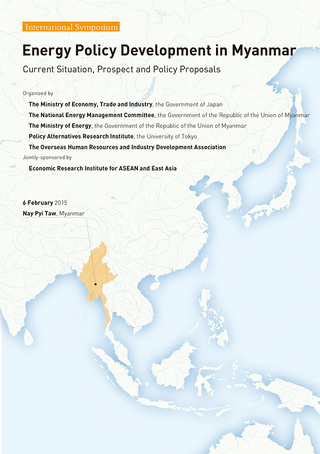 Program (Click to enlarge / view all the pages)
Program (Click to enlarge / view all the pages)
Design by Kenjiro Totsuji
Despite earning a large amount of foreign currency from natural gas exports, Myanmar suffers internally from energy poverty. On a population basis, the electrification rate is about 30%. According to a study by JETRO, electricity supply is one of the greatest factors of concern when considering investment in Myanmar. In this respect, energy is one of the most important policy areas to be addressed in Myanmar, and it is reasonable to say that improving energy access and electrifying rural areas are urgent tasks for the Thein Sein government.
So how should these tasks be addressed? The tasks are clear, but the answers are not so simple. This is because there are many constraints. For example, in the field of energy policy itself, there is a dearth of reliable data and statistics for use in drafting policies. Moreover, the legal framework for drafting and executing policy has yet to be established. However, the government has also been making steady progress. In April 2014, a national census was held for the first time in about 30 years, and some preliminary population statistics and other information have been released. Revisions to the electricity business laws and discussion of new laws, especially for the electrification of rural areas, also appear to have been advancing. Furthermore, as interest in Myanmar grows, related cooperation from international organizations and others has also been stepped up.
Against this backdrop, UTokyo Policy Alternatives Research Institute (PARI) has been researching rural electrification of Myanmar with support from ERIA. In the course of this research, in autumn of 2013 PARI received a request for human resources development (HRD) from the Myanmar Ministry of Energy1. HRD itself is one of the main areas of concern in the need for improvements following the transfer to civilian government. Such improvements should target not only the personnel of the main government ministries concerned with energy, but also a wide range of human resources, such as personnel at related research institutions, NGOs, and local governments. Since September 2014, a series of lectures and training sessions targeting a wide range of human resources have been held as an Energy Policy Workshop. The workshop sessions were attended by fifty middle-ranking managers from Myanmar's nine energy-related ministries and related organizations. Led by experts, mainly from the University of Tokyo, the sessions focused on 10 energy policy-related themes selected in conjunction with the Myanmar government. As the title of the workshop indicates, it differed from ordinary workshops in particularly aiming to have participants and experts work together on specific policy themes, analyzing the current situation, thinking and discussing, and finally producing actual policy proposals to the Myanmar government.
The workshop has other special characteristics as well. Its very significant feature was the cross-ministry aspect. Myanmar's energy policy is drafted with the involvement of nine ministries, such as the Ministry of Energy and the Ministry of Electric Power, and the organization and systems for determining an integrated direction for energy policy are lacking. In light of this issue, the National Energy Management Committee (NEMC), has been established (January 2013) and an approach to integrated energy management has just been started (Table 1). In this situation, having participants move beyond ministry boundaries to think and discuss issues together can itself be seen as a very significant attempt from the perspective of integrating energy policy.
Table 1 Structure of the National Energy Management Committee (NEMC)
| Committee | Notes |
|---|---|
| Vice president | Patron |
| Energy minister | Chairman |
| Minister of Electric Power | Vice-Chairman |
| Minister of Agriculture and Irrigation | |
| Minister of Environmental Conservation and Forestry | |
| Minister of Industry | |
| Minister of Mines | |
| Minister of National Planning and Economic Development | |
| Minister of Science and Technology | |
| Minister of Livestock, Fisheries and Rural Development | |
| Dr. Myint Soe | Ministry of Mines, Department of Geological Survey and Mineral Exploration: Geologist |
| U Win Khaing | Myanmar Engineering Society (MES): Chairman |
| U Aung Myint | General Secretary of Renewable Energy Association Myanmar |
| Deputy Minister of Energy | Joint Secretary |
| Deputy Minister of Electric Power | Joint Secretary |
Source: Prepared by the author upon order of a presidential decree on January 9, 2013
This international symposium serves as a kind of closing event for the workshop. At the same time, it is also intended to provide an opportunity for leading international experts in energy to assess the current situation in Myanmar once again from a global perspective. Moreover, by presenting the initial round of policy proposals, energy experts and the ministries of Myanmar will have a chance to discuss them. These policy proposals consist of 5 of the 10 themes studied in the workshop, which have been selected for their importance. The workshop participants were divided into five groups to study one theme each. The Symposium included a session in the morning and another in the afternoon. In the morning session, "Global Environment and Trend Surrounding Myanmar Including its Energy Sector," which was anchored on trends in international energy policies, discussions were held on the "general statement" for a policy Myanmar should take.
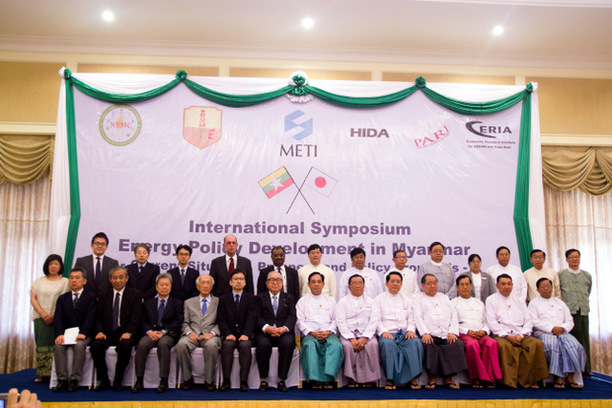
Group photo (Session 1)
At the afternoon session "Presentations of Draft Policy Proposals on Specific Policy Issues," the workshop participants presented initial policy proposals for the issues of energy policy, based on the Energy Policy Workshop. These are proposals that have been discussed with collaboration across ministerial boundaries, and their final presentation to National Energy Management Committee, NEMC is planned for May—June of this year. Furthermore, the International Symposium has been held with many participants, including officials, mainly vice-ministers, from various energy-related ministries, including the Ministry of Energy, and various private-sector organizations on the Myanmar side, and Chairman of the Japan-Myanmar Association, Hideo Watanabe, METI, HIDA, and private-sector companies on the Japanese side.
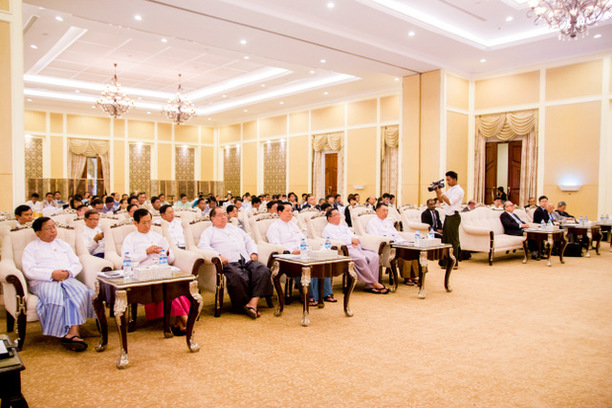
The symposium venue
Session 1: Global Environment and Trend Surrounding Myanmar including its Energy Sector
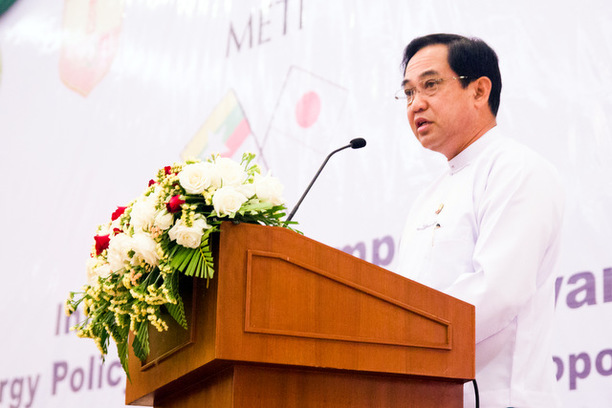
H. E. U Zay Yar Aung (Energy Minister, Myanmar)
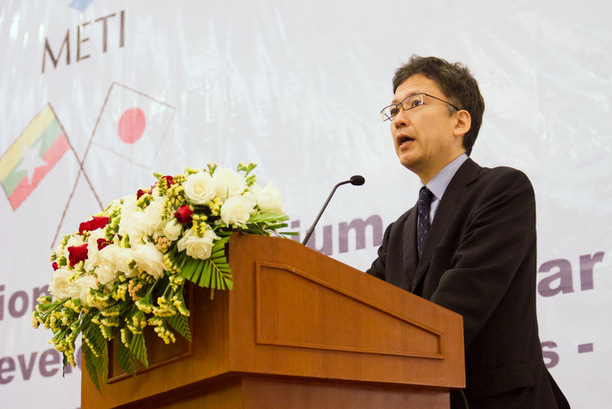
Mr. Yasuhiko Yoshida (Consulting Fellow, Deputy Director-General for International Projects Promotion, Bureau of Trade and Economic Cooperation, METI)
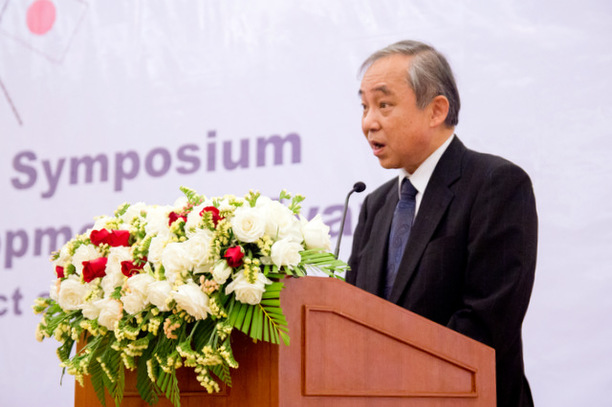
Mr. Sadao Takeda (Senior Managing Director, HIDA)
First, opening remarks were given by Minister Zay Yar Aung (Energy Minister, Myanmar), Mr. Yasuhiko Yoshida (Consulting Fellow, Deputy Director-General for International Projects Promotion, Bureau of Trade and Economic Cooperation, METI), and Mr. Sadao Takeda (Managing Director, HIDA). Minister Zay Yar Aung confirmed the importance of this type of training, noting the success of the human resources training held in Japan by HIDA in 2013. He relayed his appreciation to METI, HIDA, and the University of Tokyo for their involvement in policy training. Next, Mr. Yoshida emphasized the importance of basic infrastructure as the foundation of economic development, as well as integrated policy. He wished for policy training and this symposium to be a milestone to establish such an integrated policy. Finally, Managing Director Takeda thanked the attendees of this timely energy policy training and also Prof. Yoshikawa for leading it.
Keynote Speech 1
Presentation slides
Prof. Nobuo Tanaka (Professor, Graduate School of Public Policy, the University of Tokyo / Former Executive Director, International Energy Agency, IEA)
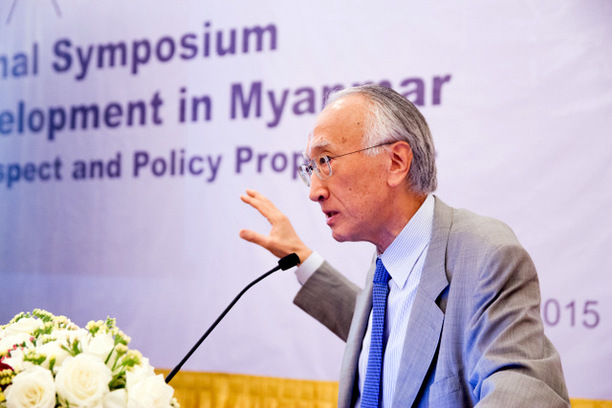
Prof. Nobuo Tanaka (Professor, Graduate School of Public Policy, the University of Tokyo / Former Executive Director, IEA)
Next, Professor Nobuo Tanaka, a former Executive Director of IEA, and Prof. S. K. Chou (Professor, Department of Mechanical Engineering, and Executive Director, Energy Studies Institute, University of Singapore) presented the keynote lecture. Prof. Tanaka presented the lecture "Challenges to the Energy Security in Asia," which focused on ensuring energy security in Asia and trends in global energy based on "Energy Outlook 2014"2 by IEA. The global energy supply system is filled with risks, and this trend is not likely to change in the foreseeable future. For example, the global oil market will continue to rely on the Middle East, where political issues caused by such groups as ISIS are still present. The problem between Ukraine and Russia does not show any sign of resolution. Although a new supply source was discovered in China with the improvement in shale gas technology, the world remains to see whether China, with its high potential production volume, would start shale gas production.
According to Prof. Tanaka, with such unstable energy supply systems, the key for Asia to achieve energy security is connectivity. For example, currently in the ASEAN, exporters and importers of energy are clearly separated. However, the area as a whole has 120% self-energy sufficiency3. In other words, by increasing connectivity flows and using the energy from ASEAN within the region, dependence on politically unstable Middle East can be reduced. In addition to hard infrastructure, such as cross-border transmission networks, soft infrastructure, such as energy market systems, can be established to contribute to collective energy security. For further security, energy diversification through the promotion of non-exhaustible resources, such as nuclear power, can positively contribute to efforts to mitigate global warming problems.
Keynote Speech 2
Presentation slides
Prof. S. K. Chou
(Professor, Department of Mechanical Engineering, and Executive Director, Energy Studies Institute, National University of Singapore)
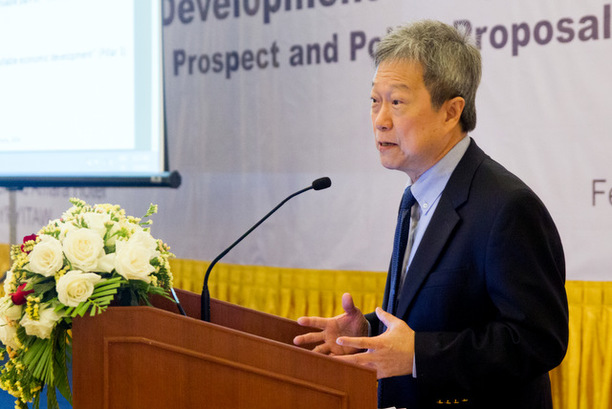
Prof. S. K. Chou
(Professor, Department of Mechanical Engineering, and Executive Director, Energy Studies Institute, National University of Singapore)
Next, Professor Chou delivered the lecture "Energy in ASEAN and Implications for Myanmar." ASEAN Economic Community (AEC) and accompanying energy market integration are beneficial for energy use and development in Myanmar. As AEC matures and investment moves freely, investing in such fields as energy development, market development, and liberalization becomes more attractive. Rent-seeking behavior4 by governments can be a disincentive to such liberalization, and should be dealt with by increasing the transparency between ASEAN governments and public corporations through cooperation and coordination. In addition, as Myanmar had a late start, it may be considered to be in an advantageous position of learning from successful cases in other countries. Especially, in the field of energy conservation and such, the potential of "Leap-flog5" should be actively examined.
Session 2: Presentations of Draft Policy Proposals on Specific Policy Issues
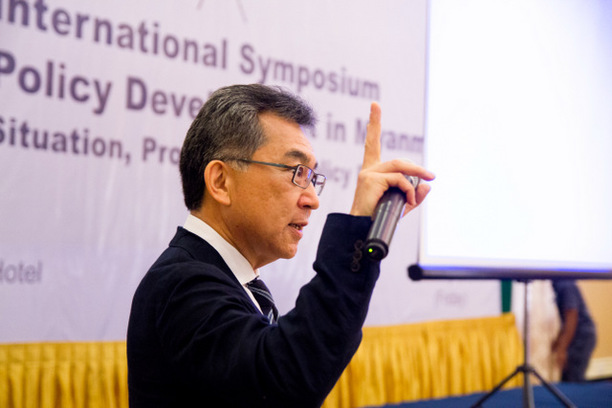
Prof. Hisashi Yoshikawa (Project Professor, Policy Alternatives Research Institute, PARI, and Graduate School of Public Policy, GraSPP, the University of Tokyo)
Prof. Yoshikawa delivered the opening remarks for the afternoon session. He confirmed that this symposium is a milestone for policy training, as Minister Zay Yar Aung stated in the morning session, with the policy proposal submission to National Energy Management Committee (NEMC) scheduled for May or June being the ultimate goal. Prof. Yoshikawa confirmed that the final goal was a policy proposal submission to NEMC. With this in mind, to enable more useful suggestions from the floor, he reconfirmed five important points emphasized at the workshops. These five aspects were 1) Evidence based efforts, 2) 3Es (Energy, Environment, and Economy), 3) Suggestions based on international best practices, 4) Ideas conforming to the market mechanism, and 5) A road map that considers the axis of time.
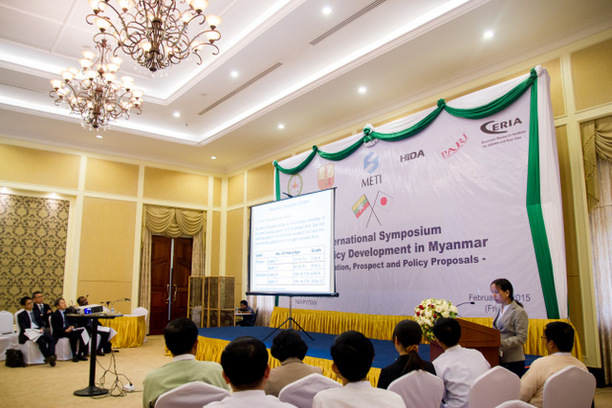
During a presentation
Group 1 - Energy Technology and Human Resource Development
Group 1, "Energy Technology and Human Resource Development", focused on the system associated with energy management6. The development of human resources in Myanmar is currently conducted by not only the Ministry of Energy and Industry but also by the Ministry of Science and Technology, which points to the availability of various styles of trainings. A desired direction for the future is a standardization of energy manager qualifications in Myanmar and the rest of the ASEAN. Thus, examples from Japan and ASEAN members were presented. For example, JICA's support for harmonization in the energy manager qualifications in Thailand was proposed. When introducing manager qualification systems, many experts have emphasized the importance of establishing vocational training schools. In the future, ASEAN should aim for harmony in various programs through such efforts as international student exchange. The role demanded of Japan is a significant one.
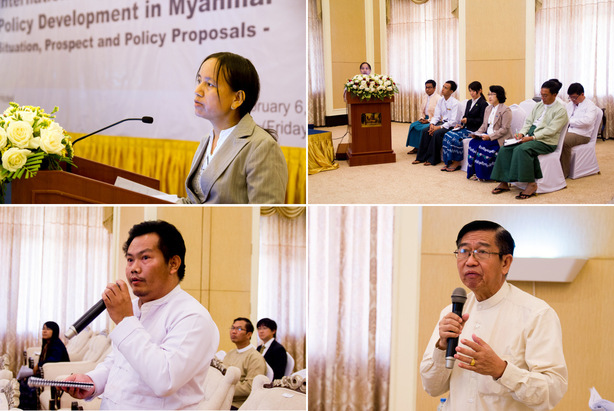
Upper: During the presentation
Lower: Comments were made by a policy maker of Ministry of Science and Technology, MOST, Myanmar, etc.
Group 2 - Electricity Policy in Myanmar
Group 2, "Electricity Policy in Myanmar", pointed out the importance of small- to medium-sized hydropower facilities. Facility enhancement for gas- and coal-based power in Myanmar is unable to catch up with the rapid increase in demand. Therefore, this issue is critical to the stable energy supply; hydropower generation with a high potential must be developed as a regulated power supply. A large-scale hydropower facility with energy production capacity surpassing 1,000 MW is economically advantageous but cannot proceed easily from the perspective of consideration for the environment and local communities7. This conclusion is assumed from previous issues encountered in the Nam Theun 2 dam in Laos. Thus, the immediate development of small- to medium-sized hydropower facilities capable of producing 100 MW or less of energy as a winwin solution for all stakeholders is more realistic. Pressing issues include developing a financial scheme to support these activities and promoting Public Private Partnership (PPP).
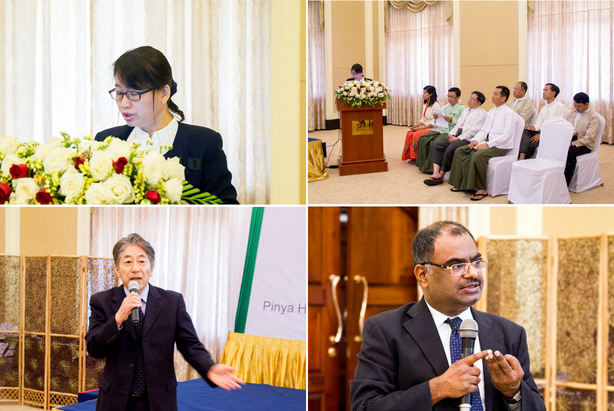
Upper: During the presentation
Lower: Comments were made by Mr. Nobuo Hashimoto (Visiting Researcher, PARI), Dr. Venkatachalam Anbumozhi (Senior Energy Economist, ERIA). etc.
Group 3 - Energy Efficiency Policy and Strategy for Myanmar
Group 3, "Energy Efficiency Policy and Strategy for Myanmar", focused on energy efficiency in the industry sector in their presentation. Modern kiln technology8 used in the cement industry was highlighted. There are dry- and wet-types of kilns. The former offers better energy efficiency. Currently, all the plants in Myanmar use wet-type kilns, and by simply switching to dry-type kilns, a certain amount of energy saving can be achieved. Meanwhile, there is quite a lot of "energy efficiency barriers", too, such as the initial cost of transition. Further, by combining soft solutions, such as implementing an energy management system, with this hard solution, more effective energy saving measures can be taken. Another point raised was the importance of social enlightenment through the promotion of "public awareness" programs for saving energy in developing nations.
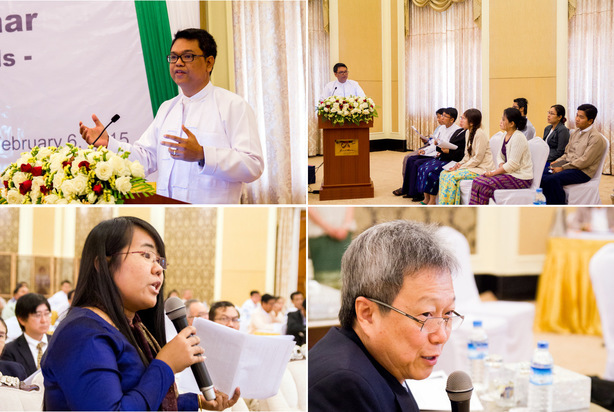
Upper: During the presentation
Lower: Comments were made by a policy maker of Ministry of Industry, Myanmar, and Prof. Chou (National University of Singapore), etc.
Group 4 - Energy Pricing, Subsidy and Energy Market
Group 4, "Energy Pricing, Subsidy and Energy Market", focused on the electricity tariff in their presentation. One of the topics in Myanmar's power policy revolves around the fact that the electricity supply cannot catch up with the rapidly increasing demand. Here, capital investment in power is needed; however, realistically, not many projects are attractive to investors. Its major drawback is the low tariff level. For example, compared with other countries in ASEAN, the electricity tariff in Myanmar is low. Thus, revising it is desired. The funding-gap9 analysis by the World Bank was introduced for the indicators of a revision schedule. Subsequently, a proposal was made to raise the electricity tariff for large-scale consumers in the private sector. Future schedules for price hikes should be scientifically appropriate based on advice from IMF.
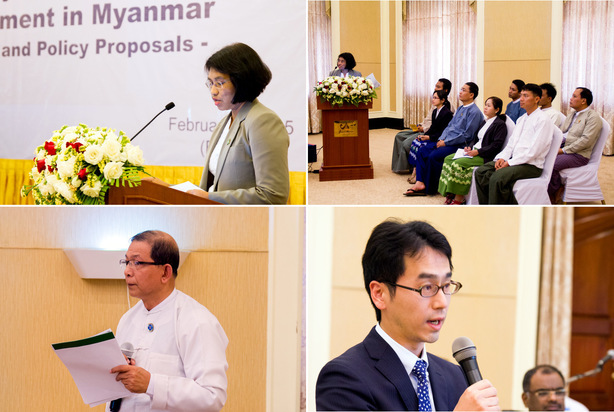
Upper: During the presentation
Lower: Comments were made by a policy maker of Ministry of Energy, Myanmar, and Dr. Masahiro Sugiyama (Assistant Professor, PARI), etc.
Group 5 - Energy Access in Rural Area and Energy Poverty
Group 5, "Energy Access in Rural Area and Energy Poverty", presented on electrification strategies. The electrification rate in Myanmar is only at 30%; Myanmar is considered to be one of the countries with the lowest energy access. Currently, the goal is to reach a 100% electrification rate by 2030, and the World Bank is preparing an electrification program through grid extension. ASEAN has seen successful examples. For example, in Vietnam, a rapid increase in electrification was seen in recent years owing to grid extension: it increased from 14% to 61% over three years especially from 1994 to 1997. However, in Myanmar, the environment for investment is different; thus, whether a similar electrification program would succeed or not is unclear. Apart from adapting to the investment environment of Myanmar, an electrification program that encourages active participation of the private sector is desired10. In the future, with the use of a mini-grid as one of the options, an electrification-related policy that takes into account financial schemes must be enacted.
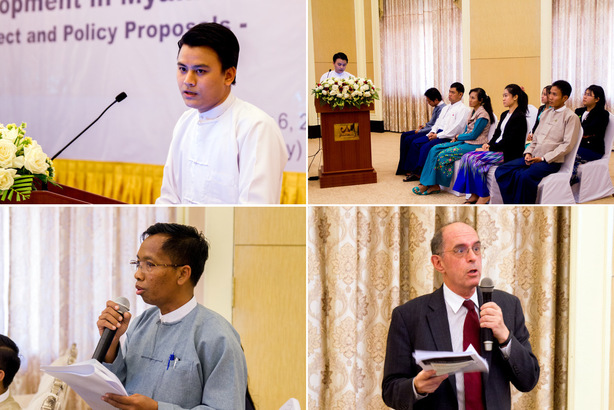
Upper: During the presentation
Comments were made by a policy maker of Ministry of Livestock, Fisheries and Rural Development, MLFRD, Myanmar, and Mr. Keith Rabin (President, KWR International), etc.
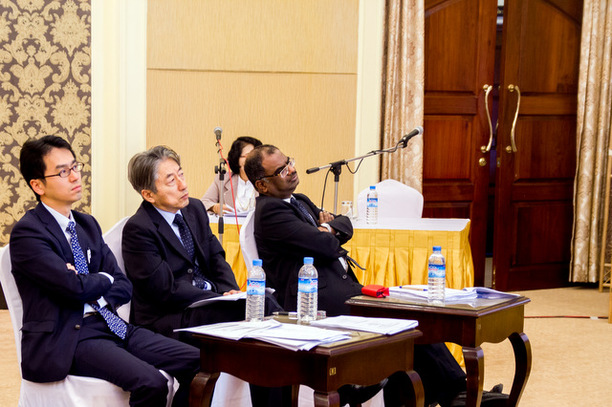
From left, Dr. Masahiro Sugiyama (Assistant Professor, PARI), Mr. Nobuo Hashimoto (Visiting Researcher, PARI) and Dr. Venkatachalam Anbumozhi (Senior Energy Economist, ERIA) , watching the presentation by Group 5
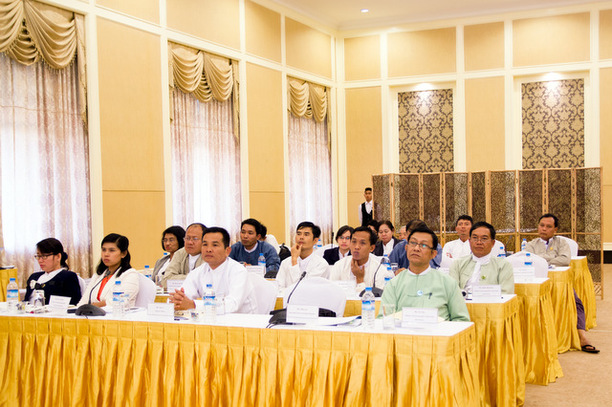
Participants of Energy Policy Workshop watching another group's presentation
Conclusion: Toward submission to NEMC
The main questions and comments after the presentations by each group are summarized in Table 2. Based on the five points indicated by Prof. Yoshikawa in the beginning, namely, 1) evidence-based efforts, 2) 3E (Energy, Environment, and Economy), 3) suggestions based on international best practices, 4) ideas conforming to the market mechanism, and 5) a road map that considers the axis of time, useful comments and questions were drawn from the participating international and domestic experts.
Table 2: Main questions and comments for each group
| Group 1: "Energy Technology and Human Resource Development" |
|---|
|
| Group 2: "Electricity Policy in Myanmar" |
|
| Group 3: "Energy Efficiency Policy and Strategy for Myanmar" |
|
| Group 4: "Energy Pricing, Subsidy, and Energy Market" |
|
| Group 5: "Energy Access in Rural Area and Energy Poverty" |
|
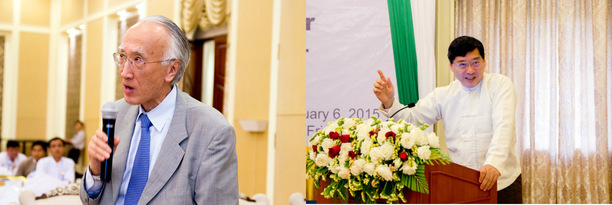
From left, Prof. Nobuo Tanaka (Former Executive Director of IEA) and Mr. Mitsutoshi Oriyama (Deputy Director, Technical Cooperation Division, METI)
Prof. Tanaka reconfirmed that the fact that administrative officers and related parties had "transcend barriers among the ministries and organizations" and cooperated in this International Symposium was in itself highly significant from a perspective of energy policy integration. With this symposium, the policy workshops had reached a milestone. However, this was not the end. Rather, it was the beginning of the submission process of final policy proposals to the National Energy Management Committee (NEMC).
As Prof. Yoshikawa emphasized in his closing remarks, future efforts should move from the "learn from others" phase to the "devote oneself to study" phase. Without accomplishing the latter phase, significant suggestions for the "preparation of investment environment for private sector participation" (suggested by METI Assistant Manager Oriyama from a practical point of view) cannot be derived. Further study aiming to achieve integrated energy management is anticipated.
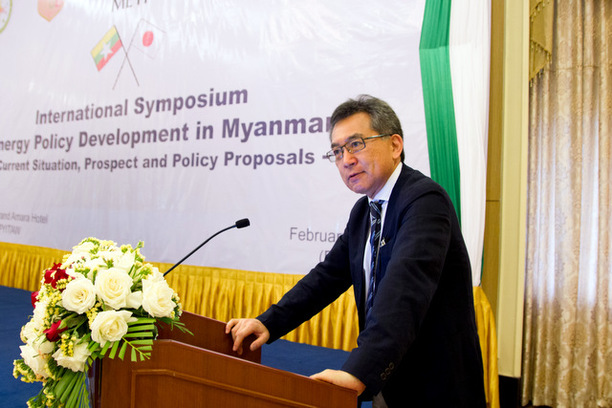
Wrap up: Prof. Hisashi Yoshikawa (PARI/GraSPP, the University of Tokyo)
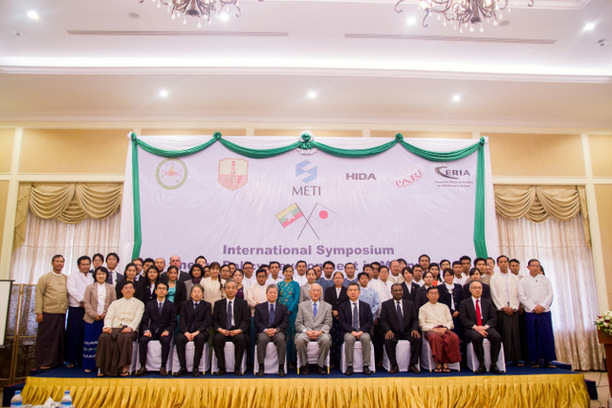
Group photo (Session 2)
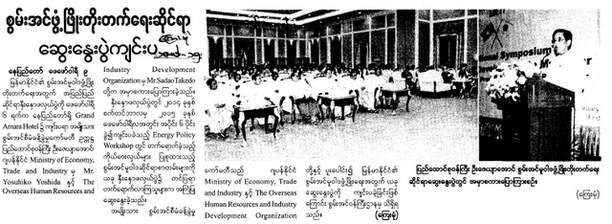
News on this symposium in Myanmar's government newspaper
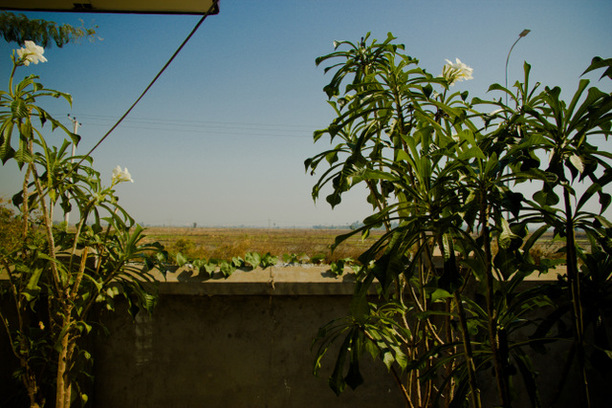
Taken from Pre-seminar venue
Photos by Ms. Takako Sato (Project Academic Support Specialist, PARI)
Related Links
Footnotes
- Refer to: Myanmar Energy Policy Workshop (in Japanese).
- Refer to: http://www.worldenergyoutlook.org/publications/weo-2014/
- Percentage of all energy consumed in the region that is produced in the region. Under present circumstances, energy resources are exported, and the region is partly dependent on energy imported from the Middle East, etc.
- Rent for energy resource development in particular is defined as profits remaining after costs of development are deducted from total income. Rent for energy resource development is not low, and rights also tend to be large. It is said that activities in pursuit of this right are conducted within the government.
- The pattern of change is advancing in one leap, without a staged process. A typical case is that of cell phones rapidly penetrating faster than fixed-line phones in developing countries.
- In Japan, plants in high energy-consumption industries that use energy above a specified level are required to appoint an energy manager. This person must have an energy manager's license.
- Please also refer to the PARI-ERI Joint Workshop. For example, "The 3rd PARI-ERI Joint Workshop Detailed Report." For reports on other past events, refer to the list found on the page: Global Energy Policy and East Asia Research Unit
- Ceramics technology used in the ceramics industry. In the cement industry, the raw material, limestone, is fed into a kiln where clinkers are calcined (calcination process). This is then pulverized to make cement (finishing process). Energy consumption in manufacturing cement mostly occurs during the calcination process.
- Difference between funds needed for investment in new equipment and the amount procurable.
- For related discussions, please refer to the workshops co-hostedsponsored by MLFRD. PARI-MLFRD Joint Workshop "The Future Direction of Rural Electrification in Myanmar" Detailed Report


